|
Sheila Collier
Portrait of a musician
Reproduced by kind permission of Sheila Collier and
Just Jazz Magazine
PART lV - The 1980s and '90s
(Click here
for Part l)
The hills are alive with the sound of music
A new place, a fresh start. The picturesque Peak
District village of Hayfield in North Derbyshire was to be my home
for the next ten years or so. At the edge of the Pennines, and with
the dark peak of Kinder Scout looming behind a cluster of stone
cottages, church, pubs, and a cricket pitch, it seemed an unlikely
place for a jazz singer, bandleader, and promoter to settle.
Together with my friend and jazz colleague, trombonist Eric Brierley
(whom I had known since I was 18 when I joined the Southside
Stompers), I lived in a former weaver's cottage on the banks of the
River Sett. Reluctantly, I left my wonderful band, the Smokies - or
Sheila Collier's Smoky City Jazz Band, to give them their full title
- to carry on without me. Under the leadership of trumpet player
Bill Smith they continued for 45 years, finally disbanding in 2007 -
a fantastic record.
Eric and I formed a small Swing band, playing every
Sunday lunchtime in one of the village pubs, first the George Hotel,
and later the Kinder Lodge. Predictably called the Hangover Band,
and later, Sheila Collier's Swinghouse. They were fantastic
sessions, enhanced by Fred, the singing landlord, and his version of
Goody Goody! People came from far and wide and packed the tiny pub.
It was great fun. There were six of us in the band - a hot
club-style rhythm section:
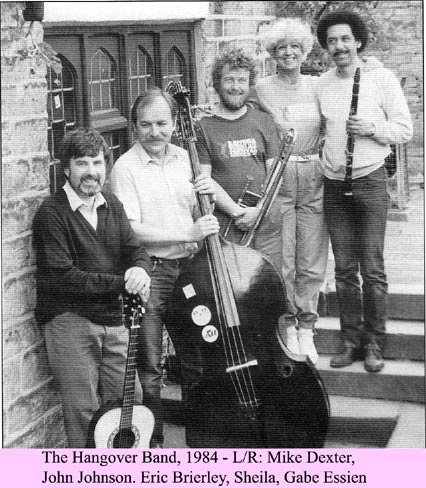 John Gordon (lead guitar), Mike Dexter (rhythm
guitar), and John Johnson (bass). The front-line: Eric Brierley
(trombone), Gabe Essien (clarinet), later John Hallam (reeds), and
myself on vocals. John Gordon (lead guitar), Mike Dexter (rhythm
guitar), and John Johnson (bass). The front-line: Eric Brierley
(trombone), Gabe Essien (clarinet), later John Hallam (reeds), and
myself on vocals.
But that wasn't enough for me! Fired with enthusiasm
from my visits to 'Jazz in Duketown' in S'Hertogenbosch, Holland, I
became obsessed
with re-creating a similar three-day festival in the little village
of Hayfield. "If I can't be with the music, I will bring the music
to me," became my mantra. With the help of fellow villager and
architect Mike Barlow (who eventually became co-director), we
gathered together a group of friends, meeting weekly in one of the
pubs, and in June, 1983, we realised my dream with the first
Hayfield Weekend Jazz Festival! Sponsorship came from the local
brewery, High Peak Borough Council, local businesses and shops, plus
a small grant from North West Arts. This enabled us to put up a
large marquee in the centre of the village by the river, and we also
used the many pubs and clubs (cricket club, Conservative club,
Labour club, etc) for further venues. This type of festival has been
done many times in England now, but I honestly believe that Hayfield
Jazz Festival was the first.
The festival had a great image right from the start.
The great Humphrey Lyttelton became our sponsor and brought his band
every year. Music Hall-style posters and programmes - 'A superlative
celebration of music in beautiful surroundings'! T-shirts, jazz
films, jazz workshops, and, of course, a New Orleans-style parade.
That's when the tragedy occurred.
Hayfield village had been intersected by a road - the
by-pass - to carry heavy traffic from the Buxton quarries through to
the industrial areas of the North West. Wagons carrying stone for
the road building came down a steep hill and up the other side.
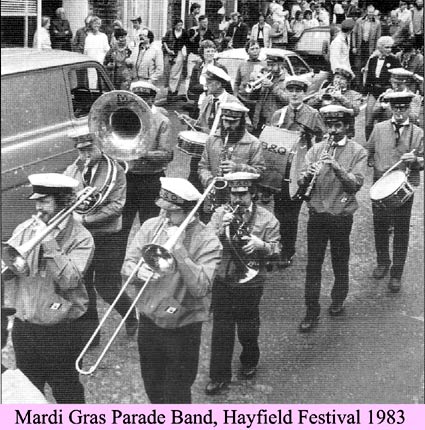 At
the bottom of the hill another road crossed the by-pass, leaving the
village cut in half. Originally, this road from Buxton was planned
to take a longer route circumventing the whole of the village, but
it was deemed to be too costly. When the festival committee planned
this first parade, we didn't want to leave out half of the village.
So we planned a route that crossed the by-pass and then came back to
the marquee. Police and the Local Authority were consulted well in
advance, and plans were put in place for the road to be closed to
all traffic one hour before the parade was due to start. By some
terrible act of fate, a heavy wagon was not stopped by the policeman
stationed at the top of the hill, and as the parade band was
half-way across the by-pass, the lorry came careering down the hill.
The driver, on seeing the musicians on the road, swerved violently
to avoid them, crashing into a house wall made of stone. Three
children, who had been standing in front of the wall to watch the
parade, were killed by the falling masonry. This terrible tragedy
will haunt me for the rest of my life. At
the bottom of the hill another road crossed the by-pass, leaving the
village cut in half. Originally, this road from Buxton was planned
to take a longer route circumventing the whole of the village, but
it was deemed to be too costly. When the festival committee planned
this first parade, we didn't want to leave out half of the village.
So we planned a route that crossed the by-pass and then came back to
the marquee. Police and the Local Authority were consulted well in
advance, and plans were put in place for the road to be closed to
all traffic one hour before the parade was due to start. By some
terrible act of fate, a heavy wagon was not stopped by the policeman
stationed at the top of the hill, and as the parade band was
half-way across the by-pass, the lorry came careering down the hill.
The driver, on seeing the musicians on the road, swerved violently
to avoid them, crashing into a house wall made of stone. Three
children, who had been standing in front of the wall to watch the
parade, were killed by the falling masonry. This terrible tragedy
will haunt me for the rest of my life.
At the time of the accident I was in my cottage
getting ready for the opening sessions in the marquee. I remember a
deadly hush surrounding me. The rest became an awful blur of
disbelief, followed by distress and anger. It pains me to write
about this terrible event - I can see the poor musicians as they
came back into the village, the awful newspaper-men selling stories
to the Sunday papers. (Denis Gilmore, one of the trumpet players,
attacked one of them.) What should have been a joyful celebration
turned into this terrible tragedy, and three young children lost
their lives. Rightly or wrongly, we decided to continue the
festival. On Sunday morning I had arranged for the Merribel Gospel
Choir to sing in the marquee. By God's blessing, the choir had
brought their preacher along with them, and the gospel session
became a moving service. His words gave us consolation and support.
I sang He's Got The Whole World In His Hands, and cried with great
sadness for this awful event.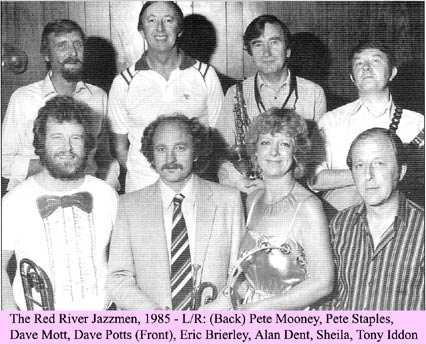
Nevertheless, Hayfield Jazz Festival carried on for a further nine
years, going from strength to strength. Trumpet player Derek Winters
joined the committee in 1986. Derek worked for the Manchester
Evening News, and with his help we obtained valuable sponsorship
from the Daily Telegraph. I had the fantastic job of booking
musicians and arranging the musical programmes. The Humphrey
Lyttelton band came every year, and we also played host to Acker
Bilk and his Paramount Jazz Band, Harry Gold and his pieces of
Eight, the Max Collie Rhythm Aces with Ken Colyer, the Chris Barber
Jazz and Blues Band, Georgie Fame and the Blue Flames, the Paul
Jones Band - plus Americans Doctor John, Al Gray, Slim Gaillard,
Barney Kessell, Bill Berry, Phil Wilson, and Plas Johnson. T.J.
Johnson made his debut at Hayfield Jazz Festival. Still a schoolboy,
he came to the Smoky City Jazz Club in Wilmslow (around 1982),
weekly at the New Inn, and satin with me on the vocals. He is one of
those musicians who had that special something right from the start.
Of course, we had the cream of the 'territory' bands too. By 1983 I
was singing with the Red River Jazz Band, lead by clarinettist Tony
Iddon.
There was the Savannah still going strong, the Dave Donohoe band,
the Dave Brennan band, Tommy Burton and his Sporting House Five, the
Smoky City Jazz Band - later on, the newly-formed Mart Rodger
Manchester Jazz, and many more. I arranged the Daily Telegraph young
musicians' jazz band contest. Cassettes were sent in, and the
winning band got to play in the marquee with Humphrey Lyttelton. One
year the Wigan Youth Jazz Band won the competition - a fantastic
band. Every year the Merribel Gospel Choir sang in the church, and
then in the marquee on Sunday morning.
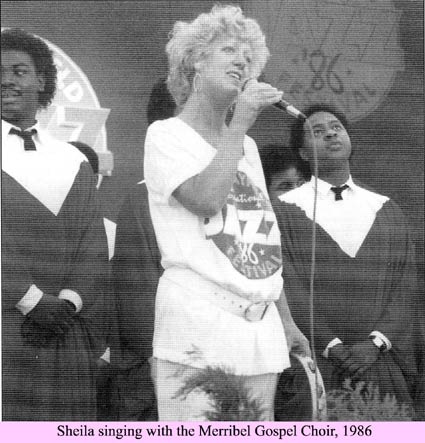 Although
the festival grew in size, it remained true to my ideals -
to make sure the musicians and bands who played there got the chance
to socialise and play together. Not just a series of concerts, but
'Jazz at the Phil'-type sessions: Plas Johnson with Doctor John and
Chris Barber; Al Gray, Eric Brierley, and Max Collie on trombones;
Slim Gaillard with Mart Rodger Manchester Jazz; for example, Danny
Moss came with Humphrey Lyttelton and Roy Williams. It was
unbelievable! And such good fun. There were pub sessions, club
sessions, workshops; the Prowisorka from Poland; Waso and Birelli
Legrane from Belgium; the Juggetts parade band from Holland, and,
one year, the Olympia Brass Band from New Orleans! With my good
friend David Ross I would compere and introduce the artists and
musicians - and I got to sing with a few of them too! Special
memories include Honeysuckle Rose with the irrepressible Slim
Gaillard, and I Can't Get Started, with Humph's band. I always sang
gospel with the Merribel Is: Let Us All Get Together With The Lord;
Precious Lord, Take My Hand, and From A Distance - my Mum's
favourite. And when Doctor John came on stage and began playing Such
A Night, the whole marquee erupted! These were truly the glory days. Although
the festival grew in size, it remained true to my ideals -
to make sure the musicians and bands who played there got the chance
to socialise and play together. Not just a series of concerts, but
'Jazz at the Phil'-type sessions: Plas Johnson with Doctor John and
Chris Barber; Al Gray, Eric Brierley, and Max Collie on trombones;
Slim Gaillard with Mart Rodger Manchester Jazz; for example, Danny
Moss came with Humphrey Lyttelton and Roy Williams. It was
unbelievable! And such good fun. There were pub sessions, club
sessions, workshops; the Prowisorka from Poland; Waso and Birelli
Legrane from Belgium; the Juggetts parade band from Holland, and,
one year, the Olympia Brass Band from New Orleans! With my good
friend David Ross I would compere and introduce the artists and
musicians - and I got to sing with a few of them too! Special
memories include Honeysuckle Rose with the irrepressible Slim
Gaillard, and I Can't Get Started, with Humph's band. I always sang
gospel with the Merribel Is: Let Us All Get Together With The Lord;
Precious Lord, Take My Hand, and From A Distance - my Mum's
favourite. And when Doctor John came on stage and began playing Such
A Night, the whole marquee erupted! These were truly the glory days.
In 1984, Mike Barlow and myself went to Eindhoven, Holland, to the
'Jazz Days; and a conference of jazz festival organisers. Playing at
the conference were the Chris Barber band, and a band from Sweden
called the Jazzin' Jacks. I invited the Jazzin' Jacks to come and
play at Hayfield Festival in June, 1985, and in return they invited
me to tour Sweden with them for three weeks that same year. Little
did I know then what the final outcome of this would be for me! This
was how I met musician Lasse Karlsson, with whom I now live (and
sing) in Helsingborg, Sweden. That story I will tell later! But now
back to Hayfield, 1985.
The Jazzin' Jacks were a big hit at Hayfield! With a line-up of Hans
Inglestan (trombone), Jack Andersson (trumpet), Lasse Karlsson
(clarinet), Bo Sjoberg (banjo), Gunnar Nilsson (bass), and Lenny
Ekstrom on drums, they played a swinging Trad-style jazz with great
panache! And they looked good too! (well, I would say that, wouldn't
I!) in their waistcoats and linen trousers. They joined in with the
parades, socialised with the girls, were very polite and charming,
Scandinavian-style. (Incidentally, next year, 2011, the Jazzin'
Jacks celebrate their 30th Anniversary with the same front-line -
Hans, Jack, and Lasse.
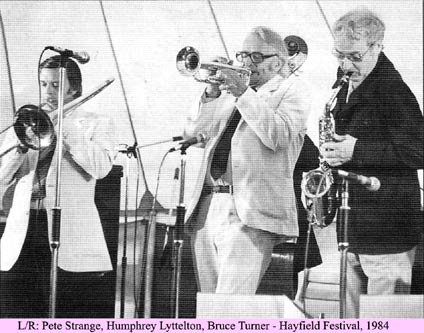 1985 was a great year for Hayfield, with the Acker Bilk Paramount
Jazz Band - Campbell Burnap on trombone; Humph, with Danny Moss
guesting, and Slim Gaillard topping the bill. Three weeks later I
flew from Manchester to Copenhagen to be met at the airport by
Lasse, and join them on a tour of Sweden. It was a wonderful
experience and such fun - Sweden is a very large country with very
few people (compared to the UK!), and we travelled hundreds of
miles, right into the Arctic Circle, playing 'coffee concerts;
evening gigs, and festivals. I saw the Count Basie Orchestra with
Joe Williams, met Maxine Sullivan, Thad Jones, and Danish
saxophonist Jesper Thilo. The weather was perfect, the 'boys'
treated me like a queen, and two days into the tour I fell in love
with Lasse Karlsson. At the end of July, 1985, I returned home
knowing I would go back to Helsingborg in late August to do a
recording with the band, and longing to be with Lasse again.
However, when I went back to Sweden it was not to be. Lasse was not
in a position to become more involved with me, and I cried all the
way back home again, trying to convince myself it was just a Summer
love-affair. Little did I know then that twenty-two years later
Lasse would search me out, and we would fall in love all over again! 1985 was a great year for Hayfield, with the Acker Bilk Paramount
Jazz Band - Campbell Burnap on trombone; Humph, with Danny Moss
guesting, and Slim Gaillard topping the bill. Three weeks later I
flew from Manchester to Copenhagen to be met at the airport by
Lasse, and join them on a tour of Sweden. It was a wonderful
experience and such fun - Sweden is a very large country with very
few people (compared to the UK!), and we travelled hundreds of
miles, right into the Arctic Circle, playing 'coffee concerts;
evening gigs, and festivals. I saw the Count Basie Orchestra with
Joe Williams, met Maxine Sullivan, Thad Jones, and Danish
saxophonist Jesper Thilo. The weather was perfect, the 'boys'
treated me like a queen, and two days into the tour I fell in love
with Lasse Karlsson. At the end of July, 1985, I returned home
knowing I would go back to Helsingborg in late August to do a
recording with the band, and longing to be with Lasse again.
However, when I went back to Sweden it was not to be. Lasse was not
in a position to become more involved with me, and I cried all the
way back home again, trying to convince myself it was just a Summer
love-affair. Little did I know then that twenty-two years later
Lasse would search me out, and we would fall in love all over again!
In 1988 I married my bass player, the lovely John Johnson, and we
set-up a bed-and-breakfast home together in the Old Bank House,
right in the centre of Hayfield village. Sadly, in 1990, Hayfield
International Jazz Festival ended. It was strangled by its own
success. As the festival grew and its popularity increased, the
little village at the foot of the Pennines could not cope. We had a
lot of trouble with crowds coming from the huge urban conurbations
of Manchester and Sheffield to drink all day and make trouble in the
village. Residents complained, the Parish Council withdrew their
support, and we decided to call it a day. One more Hayfield Jazz
Festival at Buxton Pavilion Gardens, in 1990, and that was it.
The last Hayfield Jazz Festival at the Buxton Opera House and
Pavilion Gardens in 1990 was more of a concert than a festival. We
had a lovely set from the great American saxophonist Spike Robinson,
piano by Roy Fisher. I particularly remember a beautiful rendering
of You're Blasť. Also the big youth band, in which my daughter,
Victoria, played trombone, and Stockport Schools Stage and Big Band
hosted Georgie Fame. Then it was all over. Mike Barlow and Derek
Winters moved down to Cornwall. My marriage to John Johnson broke
down, and when the Bank House finally sold (there was a recession
on) in 1994, I moved up to the northern Lake District, near Keswick,
alone but for my two lovely dogs, Bessie and Jessie.
It was time for another beginning - restoring a 16th Century
tumbledown mill cottage in the Fells. I thought my jazz days were
over.
PART V -
The Lakes - and a surprise ending!
|
 John Gordon (lead guitar), Mike Dexter (rhythm
guitar), and John Johnson (bass). The front-line: Eric Brierley
(trombone), Gabe Essien (clarinet), later John Hallam (reeds), and
myself on vocals.
John Gordon (lead guitar), Mike Dexter (rhythm
guitar), and John Johnson (bass). The front-line: Eric Brierley
(trombone), Gabe Essien (clarinet), later John Hallam (reeds), and
myself on vocals. At
the bottom of the hill another road crossed the by-pass, leaving the
village cut in half. Originally, this road from Buxton was planned
to take a longer route circumventing the whole of the village, but
it was deemed to be too costly. When the festival committee planned
this first parade, we didn't want to leave out half of the village.
So we planned a route that crossed the by-pass and then came back to
the marquee. Police and the Local Authority were consulted well in
advance, and plans were put in place for the road to be closed to
all traffic one hour before the parade was due to start. By some
terrible act of fate, a heavy wagon was not stopped by the policeman
stationed at the top of the hill, and as the parade band was
half-way across the by-pass, the lorry came careering down the hill.
The driver, on seeing the musicians on the road, swerved violently
to avoid them, crashing into a house wall made of stone. Three
children, who had been standing in front of the wall to watch the
parade, were killed by the falling masonry. This terrible tragedy
will haunt me for the rest of my life.
At
the bottom of the hill another road crossed the by-pass, leaving the
village cut in half. Originally, this road from Buxton was planned
to take a longer route circumventing the whole of the village, but
it was deemed to be too costly. When the festival committee planned
this first parade, we didn't want to leave out half of the village.
So we planned a route that crossed the by-pass and then came back to
the marquee. Police and the Local Authority were consulted well in
advance, and plans were put in place for the road to be closed to
all traffic one hour before the parade was due to start. By some
terrible act of fate, a heavy wagon was not stopped by the policeman
stationed at the top of the hill, and as the parade band was
half-way across the by-pass, the lorry came careering down the hill.
The driver, on seeing the musicians on the road, swerved violently
to avoid them, crashing into a house wall made of stone. Three
children, who had been standing in front of the wall to watch the
parade, were killed by the falling masonry. This terrible tragedy
will haunt me for the rest of my life.
 Although
the festival grew in size, it remained true to my ideals -
to make sure the musicians and bands who played there got the chance
to socialise and play together. Not just a series of concerts, but
'Jazz at the Phil'-type sessions: Plas Johnson with Doctor John and
Chris Barber; Al Gray, Eric Brierley, and Max Collie on trombones;
Slim Gaillard with Mart Rodger Manchester Jazz; for example, Danny
Moss came with Humphrey Lyttelton and Roy Williams. It was
unbelievable! And such good fun. There were pub sessions, club
sessions, workshops; the Prowisorka from Poland; Waso and Birelli
Legrane from Belgium; the Juggetts parade band from Holland, and,
one year, the Olympia Brass Band from New Orleans! With my good
friend David Ross I would compere and introduce the artists and
musicians - and I got to sing with a few of them too! Special
memories include Honeysuckle Rose with the irrepressible Slim
Gaillard, and I Can't Get Started, with Humph's band. I always sang
gospel with the Merribel Is: Let Us All Get Together With The Lord;
Precious Lord, Take My Hand, and From A Distance - my Mum's
favourite. And when Doctor John came on stage and began playing Such
A Night, the whole marquee erupted! These were truly the glory days.
Although
the festival grew in size, it remained true to my ideals -
to make sure the musicians and bands who played there got the chance
to socialise and play together. Not just a series of concerts, but
'Jazz at the Phil'-type sessions: Plas Johnson with Doctor John and
Chris Barber; Al Gray, Eric Brierley, and Max Collie on trombones;
Slim Gaillard with Mart Rodger Manchester Jazz; for example, Danny
Moss came with Humphrey Lyttelton and Roy Williams. It was
unbelievable! And such good fun. There were pub sessions, club
sessions, workshops; the Prowisorka from Poland; Waso and Birelli
Legrane from Belgium; the Juggetts parade band from Holland, and,
one year, the Olympia Brass Band from New Orleans! With my good
friend David Ross I would compere and introduce the artists and
musicians - and I got to sing with a few of them too! Special
memories include Honeysuckle Rose with the irrepressible Slim
Gaillard, and I Can't Get Started, with Humph's band. I always sang
gospel with the Merribel Is: Let Us All Get Together With The Lord;
Precious Lord, Take My Hand, and From A Distance - my Mum's
favourite. And when Doctor John came on stage and began playing Such
A Night, the whole marquee erupted! These were truly the glory days. 1985 was a great year for Hayfield, with the Acker Bilk Paramount
Jazz Band - Campbell Burnap on trombone; Humph, with Danny Moss
guesting, and Slim Gaillard topping the bill. Three weeks later I
flew from Manchester to Copenhagen to be met at the airport by
Lasse, and join them on a tour of Sweden. It was a wonderful
experience and such fun - Sweden is a very large country with very
few people (compared to the UK!), and we travelled hundreds of
miles, right into the Arctic Circle, playing 'coffee concerts;
evening gigs, and festivals. I saw the Count Basie Orchestra with
Joe Williams, met Maxine Sullivan, Thad Jones, and Danish
saxophonist Jesper Thilo. The weather was perfect, the 'boys'
treated me like a queen, and two days into the tour I fell in love
with Lasse Karlsson. At the end of July, 1985, I returned home
knowing I would go back to Helsingborg in late August to do a
recording with the band, and longing to be with Lasse again.
However, when I went back to Sweden it was not to be. Lasse was not
in a position to become more involved with me, and I cried all the
way back home again, trying to convince myself it was just a Summer
love-affair. Little did I know then that twenty-two years later
Lasse would search me out, and we would fall in love all over again!
1985 was a great year for Hayfield, with the Acker Bilk Paramount
Jazz Band - Campbell Burnap on trombone; Humph, with Danny Moss
guesting, and Slim Gaillard topping the bill. Three weeks later I
flew from Manchester to Copenhagen to be met at the airport by
Lasse, and join them on a tour of Sweden. It was a wonderful
experience and such fun - Sweden is a very large country with very
few people (compared to the UK!), and we travelled hundreds of
miles, right into the Arctic Circle, playing 'coffee concerts;
evening gigs, and festivals. I saw the Count Basie Orchestra with
Joe Williams, met Maxine Sullivan, Thad Jones, and Danish
saxophonist Jesper Thilo. The weather was perfect, the 'boys'
treated me like a queen, and two days into the tour I fell in love
with Lasse Karlsson. At the end of July, 1985, I returned home
knowing I would go back to Helsingborg in late August to do a
recording with the band, and longing to be with Lasse again.
However, when I went back to Sweden it was not to be. Lasse was not
in a position to become more involved with me, and I cried all the
way back home again, trying to convince myself it was just a Summer
love-affair. Little did I know then that twenty-two years later
Lasse would search me out, and we would fall in love all over again!